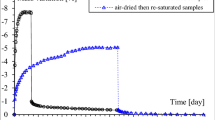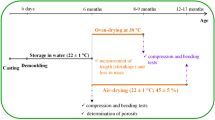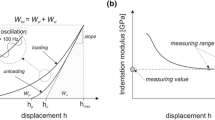Abstract
This study deals with the effect of re-saturation after drying on the evolution of the mechanical behaviour of a standard mortar. Uniaxial and triaxial compression tests were performed according to the saturation state (saturated, dried in an oven at 60 °C until constant weight, re-saturated with water in different proportions). The results obtained show that even if the strength increases after oven-drying, the micro-cracking induced at the same time has an important influence on the evolution of the mechanical properties after re-saturation. The uniaxial and triaxial compressive strengths decrease regularly with re-saturation. The strength of vacuum re-saturated samples is lower than that of saturated samples (not subjected to drying) but the decrease is less marked in the case of triaxial deviatoric tests due to the presence of 15 MPa of confining pressure. Moreover, an additional decrease of Young’s modulus is observed in uniaxial compression after vacuum re-saturation while this modulus shows no variation in triaxial compression due to the presence of confining pressure. In addition, the elastic limit stress depends on the degree of re-saturation.









Similar content being viewed by others
References
Bažant ZP, Wittmann FH (1982) Creep and Shrinkage in Concrete Structures. John Wiley and Sons, UK
Wittmann FH (1982) Creep and shrinkage mechanisms. In: Wittmann FH (ed) Bažant ZP. Creep and Shrinkage in Concrete Structures, J. Wiley and Sons, pp 129–161
Acker P (1988) Comportement mécanique du béton : apport de l’approche physico-chimique. PhD dissertation, Ecole Nationale des Ponts et Chaussées, Rapport de Recherche LPC n152,Paris [in French]
Baroghel-Bouny V (1994) Caractérisation des pâtes de ciment et des bétons, PhD dissertation, Ecole Nationale des Ponts et Chaussées, Paris [in French]
Colina H, Acker P (2000) Drying cracks: kinematics and scale laws. Mater Struct 33:101–107
Bartlett FM, MacGregor JG (1994) Effect of moisture condition on concrete core strengths. ACI Mater J 91(3):227–236
Popovics S (1986) Effect of curing method and moisture condition on compressive strength of concrete. ACI Mater J 83:650–657
Neville AM (1995) Properties of Concrete, 4th edn. Longman Group
Hearn N (1999) Effect of shrinkage and load-induced cracking on water permeability of concrete. ACI Mater J 96:234–241
Bisschop J, Pel L, van Mier JGM (2001) Effect of aggregate size and paste volume on drying shrinkage microcracking in cement-based composites. In: Ulm F-J, Bažant ZP, Wittmann FH (eds) Creep, shrinkage & durability mechanics of concrete and other quasi-brittle materials. Elsevier, Amsterdam, pp 75–80
de Sa C, Benboudjema F, Thiery M, Sicard J (2008) Analysis of micro-cracking induced by drying shrinkage. Cem Concr Comp 30:947–956
Yurtdas I (2003) Couplage comportement mécanique et dessiccation des matériaux à matrice cimentaire : étude expérimentale sur mortiers, PhD dissertation, Université des Sciences et Technologies de Lille and Ecole Centrale de Lille [in French]
Yurtdas I, Burlion N, Skoczylas F (2004) Triaxial mechanical behaviour of mortar: effects of drying. Cem Concr Res 34:1131–1143
Yurtdas I, Burlion N, Skoczylas F (2004) Experimental characterisation of the drying effect on uniaxial mechanical of mortar. Mater Struct 37:170–176
Burlion N, Bourgeois F, Shao JF (2005) Effect of drying on mechanical behaviour of concrete. Cem Concr Comp 27:367–379
Yurtdas I, Burlion N, Shao JF, Li A (2011) Evolution of the mechanical behaviour of a high performance self-compacting concrete under drying. Cem Concr Comp 33:380–388
Burlion N, Skoczylas F, Dubois T (2003) Induced anisotropic permeability due to drying of concrete. Cem Concr Res 33:679–687
Mills RH (1960). Strength-maturity relationship for concrete which is allowed to dry. In: RILEM International Symposium on concrete and reinforced concrete in hot country, Haîfa
Wittmann FH (1968) Surface tension, shrinkage and strength of hardened cement paste. Mater Struct 1(6):547–552
Okajima T, Ishikawa T, Ichise K (1980) Moisture effect on the mechanical properties of cement mortar. Trans Jpn Conc Inst 2:125–132
Zimmerman RG (1972) Major factors affecting the multiaxial compressive strength of plain concrete, In: The Deformations and the Rupture of Solids Subjected to Multiaxial Stresses Proceedings of RILEM International Symposium, Cannes, pp 257–272
Palaniswamy R, Shah SP (1974) Fracture and stress-strain relationship of concrete under triaxial compression. J Struct Div ASCE ST5 100(5):901–916
Vu XH, Malecot Y, Daudeville L, Buzaud E (2009) Experimental analysis of concrete behaviour under high confinement: effect of the saturation ratio. Int J Solid Struct 46:1105–1120
Akroyd ZNW (1961) Concrete under triaxial stress. Mag Conc Res 13:111–118
Gilkey HJ (1937) The moist curing of concrete. Eng News Rec 119:630–633
Pihlajavaara SE (1974) A review of some of the main results of a research on the ageing phenomena of concrete, effect of moisture conditions on strength, shrinkage and creep of mature concrete. Cem Concr Res 4:761–771
Price WH (1951) Factors influencing concrete strength. J ACI 47:417–432
Beddoe RE, Lippok R (1999) Hygral stress in hardened cement paste. Mater Struc 32:627–634
Dupain R, Lanchon R, Saint-Arroman J-C (2004) Granulats, Sols, Ciments et Bétons. Cateilla, Paris [in French]
Skoczylas F, Burlion N, Yurtdas I (2007) About drying effects and poro-mechanical behaviour of mortars. Cem Concr Comp 29:383–390
Yurtdas I, Burlion N, Skoczylas F (2008) Comportement différé des mortiers soumis au séchage et effet induit sur la perméabilité. Eur J Environ Civ Eng 12:701–721 [in French]
Acknowledgements
The authors would like to thank Drs. S.Y. Xie and T. Rougelot for their technical help in laboratory testing.
Author information
Authors and Affiliations
Corresponding author
Rights and permissions
About this article
Cite this article
Yurtdas, I., Burlion, N. & Shao, J.F. Evolution of mechanical behaviour of mortar with re-saturation after drying. Mater Struct 48, 3343–3355 (2015). https://doi.org/10.1617/s11527-014-0403-7
Received:
Accepted:
Published:
Issue Date:
DOI: https://doi.org/10.1617/s11527-014-0403-7




